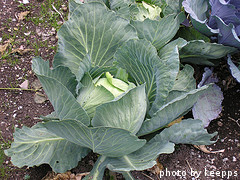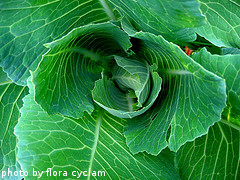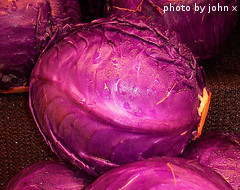Growing Cabbage
If you are looking for information about growing cabbage, you've
come to the right place. Cabbage is a cool weather crop that is
easy to plant, simple to care for and easy to harvest.

Cabbage plants need 6-8 hours of sunlight per day and are usually ready for harvest 45-105 days after planting, depending on the variety. Usually, the larger the cabbage head, the longer it takes to mature. Cabbage thrives in temperatures of 60-70 degrees F, although established plants can tolerate nighttime temperatures that dip to freezing or even slightly below. If temperatures remain much higher than 80 degrees for extended periods, the plants will virtually stop growing and bolt fairly quickly. Cabbage plants are generally not suitable for growing in containers, although if you had a large enough pot, it may be possible.
Cabbage is planted by transplanting 3 inch tall seedlings into the garden. Seedlings can be purchased from local garden centers. You can also grow your own seedlings by planting the seeds indoors about 7 weeks before the last expected frost in your area. They will be ready to transplant about a month before the first expected frost in your area, which is typically when they are planted in their permanent home.
When growing cabbage, it's important to leave enough space between plants as they can get quite large. Some varieties of cabbage can produce heads weighing 15-20 pounds. Other varieties produce much smaller heads, weighing a couple of pounds each. The world record cabbage was grown in Alaska in 2009 and weighed in at 127 pounds!
Cabbage should not be grown in the same place two years in a row. It uses too many nutrients from the soil in a single growing season, so crop rotation is key. In addition, this will help prevent disease problems in the future. It's possible to grow 2 cabbage crops per year in some climates. If you're growing two cabbage crops per year, you need at least 4 different placed to grow your cabbage, so that you can practice good crop rotation.
In our own garden, we grow faster maturing varieties in the spring and longer maturing varieties in the fall. We also grow our cabbage in 6 different areas of our garden, so that each area gets 2 years off from growing cabbage - we grow non-brasica plants in those spots during the off years. In the spring, we like to grow a loose-leaf Chinese cabbage type, along with a traditional variety that produces smaller heads. Our spring cabbage crop is eaten fresh - we don't worry about freezing or canning it or making sauerkraut. In the fall, we grow the varieties that produce the large, tight heads. This is the cabbage that we keep for the winter months, either by storing whole heads or freezing it or canning sauerkraut.

Growing cabbage is a great way to maximize space in your garden as the spring crop can be harvested early enough to plant summer vegetables in the same location. A fall crop can be planted again after the summer vegetables have finished producing. Cabbage that is allowed to mature in cool fall weather is especially sweet. Since cabbage tolerates cool weather and moderate night-time freezes quite well, longer maturing varieties can often be grown in the autumn months.
For the most part, cabbage varieties that produce smaller heads mature faster than those that produce larger heads. And, cabbage doesn't do well in hot weather. So, try growing smaller varieties in the spring, so that they will be ready for harvest before the hot temps of summer arrives. In addition, Chinese cabbage varieties that are loose-leaf tend to mature quite quickly (usually in 2 months or less) are great options for spring cabbage crops.
Cabbage can be eaten raw in coleslaw or made into sauerkraut. It can be steamed, boiled, sauteed, and even roasted. One of our favorite dishes is cabbage leaves stuffed with a meat and rice mixture.
Quick Overview of Growing Cabbage
Planting: Seeds can be started indoors 7 weeks prior to last expected freeze, sow seeds 1/2 inch deep, transplant seedlings 4 weeks before last expected frost when they are 3 inches tall
Fertilizing: Use balanced fertilizer and apply once when seedlings are transplanted, when they reach 6 inches tall and again when the heads form
Watering: Need about 1.5 inches of rain per week, keep soil evenly moist but not wet
Harvesting: Cut off heads when they are firm and tight
Recipes: Cabbage can be steamed, boiled, sauteed, roasted, fried and eaten raw
Click on the following links to learn more about cabbage.

Click here to learn about planting cabbage
Click here to learn about fertilizing and watering cabbage plants
Click here for information about harvesting cabbage
Click here to move from our Growing Cabbage main page to our Cabbage Varieties page
Click here for some of our favorite cabbage recipes